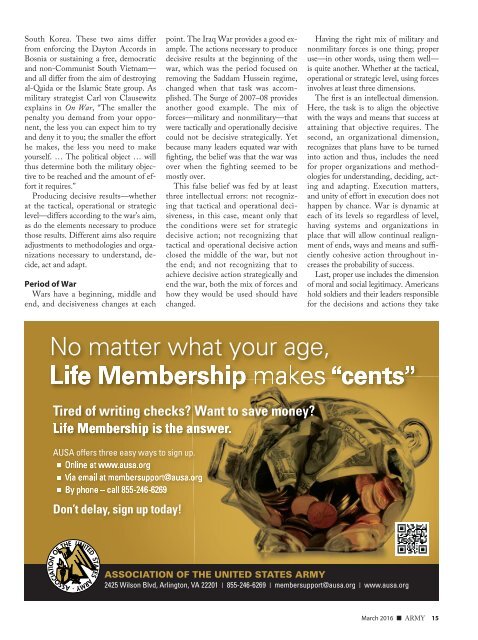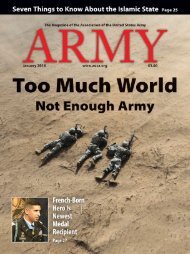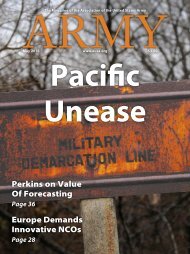Army - Stimulating Simulation
You also want an ePaper? Increase the reach of your titles
YUMPU automatically turns print PDFs into web optimized ePapers that Google loves.
South Korea. These two aims differ<br />
from enforcing the Dayton Accords in<br />
Bosnia or sustaining a free, democratic<br />
and non-Communist South Vietnam—<br />
and all differ from the aim of destroying<br />
al-Qaida or the Islamic State group. As<br />
military strategist Carl von Clausewitz<br />
explains in On War, “The smaller the<br />
penalty you demand from your opponent,<br />
the less you can expect him to try<br />
and deny it to you; the smaller the effort<br />
he makes, the less you need to make<br />
yourself. … The political object … will<br />
thus determine both the military objective<br />
to be reached and the amount of effort<br />
it requires.”<br />
Producing decisive results—whether<br />
at the tactical, operational or strategic<br />
level—differs according to the war’s aim,<br />
as do the elements necessary to produce<br />
those results. Different aims also require<br />
adjustments to methodologies and organizations<br />
necessary to understand, decide,<br />
act and adapt.<br />
Period of War<br />
Wars have a beginning, middle and<br />
end, and decisiveness changes at each<br />
point. The Iraq War provides a good example.<br />
The actions necessary to produce<br />
decisive results at the beginning of the<br />
war, which was the period focused on<br />
removing the Saddam Hussein regime,<br />
changed when that task was accomplished.<br />
The Surge of 2007–08 provides<br />
another good example. The mix of<br />
forces—military and nonmilitary—that<br />
were tactically and operationally decisive<br />
could not be decisive strategically. Yet<br />
because many leaders equated war with<br />
fighting, the belief was that the war was<br />
over when the fighting seemed to be<br />
mostly over.<br />
This false belief was fed by at least<br />
three intellectual errors: not recognizing<br />
that tactical and operational decisiveness,<br />
in this case, meant only that<br />
the conditions were set for strategic<br />
decisive action; not recognizing that<br />
tactical and operational decisive action<br />
closed the middle of the war, but not<br />
the end; and not recognizing that to<br />
achieve decisive action strategically and<br />
end the war, both the mix of forces and<br />
how they would be used should have<br />
changed.<br />
Having the right mix of military and<br />
nonmilitary forces is one thing; proper<br />
use—in other words, using them well—<br />
is quite another. Whether at the tactical,<br />
operational or strategic level, using forces<br />
involves at least three dimensions.<br />
The first is an intellectual dimension.<br />
Here, the task is to align the objective<br />
with the ways and means that success at<br />
attaining that objective requires. The<br />
second, an organizational dimension,<br />
recognizes that plans have to be turned<br />
into action and thus, includes the need<br />
for proper organizations and methodologies<br />
for understanding, deciding, acting<br />
and adapting. Execution matters,<br />
and unity of effort in execution does not<br />
happen by chance. War is dynamic at<br />
each of its levels so regardless of level,<br />
having systems and organizations in<br />
place that will allow continual realignment<br />
of ends, ways and means and sufficiently<br />
cohesive action throughout increases<br />
the probability of success.<br />
Last, proper use includes the dimension<br />
of moral and social legitimacy. Americans<br />
hold soldiers and their leaders responsible<br />
for the decisions and actions they take<br />
March 2016 ■ ARMY 15

















